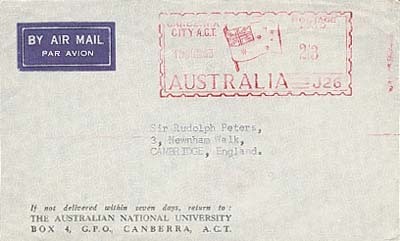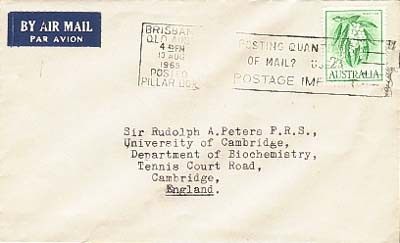Rudolph Peters was born13 April 1889 in Kensington, London, the only son and elder child of Albert Peters a general practitioner and his wife Agnes Watts. He was educated at Cambridge University and St. Bartholomew’s Hospital, London (graduating in medicine with MB and B. Chir.1915), although he entered as a classics scholar. He gained his higher research degree of MD in 1919. After teaching briefly at Cambridge, he accepted the recently established Whitley Chair of Biochemistry at Oxford which he held from 1923 until his retirement in 1954.
Between 1928 and 1935, Peters and his Oxford colleagues succeeded in showing for the first time the precise activity of a vitamin in the body. Working with vitamin B1 or thiamine, (the anti-beriberi factor first described by Christiaan Eijkman) they fed pigeons on a diet of polished rice. This was free of thiamine and produced a number of debilitating symptoms in most of the birds. As one of these symptoms was convulsions, Peters suspected that the thiamine deficiency could have involved the central nervous system.
The first hint of the role of thiamine was provided by the failure of minced pigeon brain to take up as much oxygen as the brain of normally fed birds. The lesion was promptly reversed by the addition of thiamine to the experimental medium. Further work showed an accumulation of lactic acid in the pigeon brain. As lactic acid is one of the intermediate products in the metabolism of carbohydrates into carbon dioxide and water, it seemed clear that thiamine must be an essential ingredient in this metabolic pathway. Peters’ work provided the first proof of the action of any vitamin upon an enzyme system in vitro.
The first cover was sent airmail from the Australian National University, Canberra, A.C.T., and it would be a safe bet that the letter emanated from the Department of Biochemistry, where Arnold Hughes Ennor held the Foundation Chair (Ennor had previously worked with Peters in London). The cover was postmarked with a red boxed postage paid 2/3d Canberra City A.C.T., with the unfurled Australian flag, and it was addressed to Sir Rudolf’s home address in Cambridge. There were no markings on the reverse (Figure 1).

The second airmail cover was addressed to Sir Rudolf Peters FRS at his laboratory address in the Dept. of Biochemistry, Cambridge and the green 2/3d wattle stamp was postmarked with a roller cancel and a boxed BRISBANE, QLD AUST , 4 45 PM, 13 AUG 1965, POSTED PILLOW BOX cancel. The reverse had the senders name inscribed as Peter B. Oelrichs, The Animal Research Institute, Yerongpilly, Queensland, a researcher who published in the Australian Journal of Chemistry (Figure 2).

Peters had a worldwide reputation in academia, and gave frequent lectures internationally. He received many honorary doctorates, including a D. Sc. from the Australian National University in 1961. He had an association with Canada also, for he was a visiting professor at Dalhousie University in Halifax, in 1963. He was not only a Fellow of the Royal Society, London, but also one of its gold medalists.
On a more personal note, he was a competent violinist and enjoyed playing chamber music with friends. He was a kind man, who inspired trust and affection. His speech was apt to come in bursts, and he expressed enthusiasm, an alertness with a sense of fun. He was very involved in education, of students and colleagues, in addition to his extensive biochemical research.